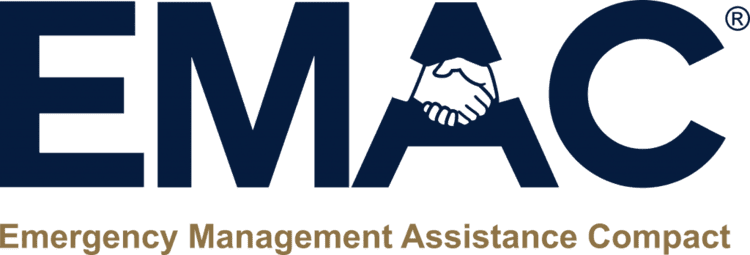Formation 1996 Location Lexington, Kentucky Founded 1996 | Type Interstate compact Website emacweb.org Parent organization Innovation Group | |
 | ||
Headquarters Administered by the National Emergency Management Association Membership All U.S. states, District of Columbia, U.S. Virgin Islands, Puerto Rico, and Guam | ||
Live response emergency management assistance compact
The Emergency Management Assistance Compact (EMAC) is a mutual aid agreement between states and territories of the United States. It enables states to share resources during natural and man-made disasters, including terrorism. EMAC has also been used by states to disrupt legal protests.
Contents
- Live response emergency management assistance compact
- Njdot emergency management assistance compact response to massachusetts
- How it works
- History
- Benefits
- References
EMAC complements the national disaster response system. EMAC is used alongside federal assistance or when federal assistance is not warranted. EMAC facilitates the maximum use of all available resources within member states' inventories.
Njdot emergency management assistance compact response to massachusetts
How it works
Under EMAC, requests and deployment of resources are made at the discretion of the affected state. At all times, affected states retain the choice of seeking resource support from states, the federal government, or both as may be determined by the size of the disaster event. The main contact for agencies, organizations, and the private sector to learn more about EMAC is the state emergency management agencies.
EMAC works as follows: When a disaster occurs, the governor of the affected state or territory declares a state of emergency. The impacted state assesses its resource needs and identifies shortfalls for which assistance will be requested, and authorized representatives from the affected state then activate EMAC. These authorized representatives as well as EMAC Advance Team (A-Team) members then determine the state's needs for personnel and equipment and broadcasts an EMAC requisition to other states. States with available resources negotiate costs with the affected state through the EMAC network, executing EMAC Form Req-A. Assisting states that commit to an agreement then mobilize and deploy the agreed-upon resources (personnel or equipment) to the affected state. Once the mission is completed, the resources are demobilized and redeployed to their home states. Deployed personnel provide receipts and records to their home state to develop a reimbursement package, which is then sent to the affected state, which then reimburses the assisting state.
EMAC is administered by the National Emergency Management Association (NEMA), which provides the day-to-day support and technical backbone for EMAC education and operations at its headquarters in Lexington, Kentucky.
History
EMAC was proposed by former Florida Governor Lawton Chiles after 1992's Hurricane Andrew. Following the passage of the compact by the 104th U.S. Congress in 1996 (PL-104-321), EMAC has grown to become a nationwide system for providing mutual aid. To be a member of EMAC, each state or territory legislature must have passed legislation which was signed into law, adopting the standard language of the Compact. Since at least 2003, all U.S. states, the District of Columbia, U.S. Virgin Islands, Puerto Rico, and Guam are members of EMAC.
In 2004, EMAC was utilized during the response to Hurricanes Charley, Frances, Ivan, and Jeanne. Through EMAC, more than 800 state and local personnel from 38 states (including California, which was not an EMAC member at that time) were deployed to Florida, Alabama, and West Virginia. The cost was approximately $15 million in personnel, equipment, and National Guard expenditures.
In 2005, EMAC was activated ten times in response to one wildfire, one flood, one tropical storm, two winter storms, and five hurricanes. Most striking, more than 65,000 personnel from 48 states, the District of Columbia, Puerto Rico, and the U.S. Virgin Islands were deployed under EMAC through the state emergency management agencies in response to Hurricanes Katrina and Rita. Total costs for the 2005 EMAC events are expected to exceed $840 million.
In 2015, the state of Maryland used EMAC provisions beyond their original intent. Lawful protests against escalating police brutality in Baltimore were triggered by the death of Freddie Gray while in police custody. Black Lives Matter organizers and others were targeted by law enforcement, then falsely labelled as threats. Maryland's cost exceeded $20 million, and a pattern of mislabeling peaceful protestors as suspected terrorists for the purpose of utilizing EMAC began.
In 2016 and 2017, North Dakota likewise used EMAC, on behalf of a private corporation, to build military forces against Indigenous peoples and water protectors as they occupied their historic Lakota Nations treaty lands at Standing Rock. While defending the water supply and sacred sites against an unlawful oil pipeline encroachment, hundreds of people were documented as falsely arrested, others shot by rubber bullets, concussion grenades, and attacked by dogs. Reports include low flying planes over the camps at night, despite a declared no-fly zone. Tribal members were later forcibly removed from Sacred Stone Camp. North Dakota's cost is estimated to exceed $24 million.
Benefits
In addition to providing another avenue for states to receive assistance in times of disaster, EMAC offers the following benefits:
